Abstract
Aim:
The social media platform X, formerly known as Twitter, has emerged as a significant hub for healthcare-related conversations and sharing information. This study aims to investigate the impact and reach of the #physiotherapy hashtag on the X platform.
Methods:
We collected and analyzed tweets containing the hashtag #physiotherapy posted between September 1, 2022, and September 1, 2023. Data was retrieved from X using the Fedica analytics platform on October 26, 2023. The data were analyzed and expressed in number and percentage and categorical data were tested by chi-square test.
Results:
Over the course of one year, a total of 57,788 tweets were shared using #physiotherapy by 21,244 users, generating a remarkable 108,743,911 impressions. On average, there were 6 tweets posted per day (with a range from 3 to 9). Among the users, the majority (42%) had between 100 and 1000 followers, while 31.6% had fewer than 100 followers. The top three countries contributing to #physiotherapy tweets were the UK (29.9%), India (23.75%), and the USA (11.85%). An analysis of sentiment revealed that 84% of the tweets had a neutral tone, while 9% were positive and 7% were negative (P < 0.0001).
Conclusions:
The examination of tweets related to #physiotherapy unveiled a vibrant global dialogue, with active engagement from diverse backgrounds. Notably, contributions from the UK, India, and the USA were prominent.
Keywords
Social media, sentiment analysis, physical therapy modalities, delivery of health care, information dissemination, communication, X (formerly Twitter)Introduction
Social media has emerged as a vital tool in healthcare communication, revolutionizing the way healthcare information is disseminated, and fostering meaningful interactions between healthcare providers, patients, and the broader public [1]. Its importance is multifaceted, as it enables rapid dissemination of health-related news, educational content, and updates, which is especially crucial during public health crises and emergencies. Social media also empowers patients to become more informed and engaged in their own healthcare, offering a platform for sharing experiences, seeking advice, and connecting with support networks [2]. Additionally, it serves as a medium for healthcare organizations and professionals to build trust, share expertise, and address misconceptions, ultimately enhancing healthcare access and outcomes [3–5].
Analyzing health-related hashtags holds significant importance in today’s digital age, as it offers valuable insights into public health trends, patient experiences, and healthcare practices. By dissecting the usage and engagement with such hashtags, healthcare professionals and researchers can gain a deeper understanding of prevalent health issues, identify emerging trends, and assess the impact of health interventions and campaigns [6, 7]. The social media platform X (formerly Twitter) in particular is broadly utilized by healthcare professionals and researchers, as well as by patients [3, 8, 9]. Previous studies have proved that the scrutiny of health-related hashtags is a critical tool for shaping evidence-based healthcare strategies, fostering health literacy, and improving the overall health and well-being of individuals and societies in a broad sense [10–12].
Physiotherapy (medical education subject heading defines it as “therapeutic modalities frequently used in physical therapy specialty by physical therapists or physiotherapists to promote, maintain, or restore the physical and physiological well-being of an individual”) plays a pivotal role in promoting physical well-being, managing chronic conditions, and aiding in rehabilitation and recovery. When individuals are well-informed about the capabilities of physiotherapy, they are more likely to seek timely and appropriate care, resulting in early intervention and faster recovery [13]. This knowledge empowers individuals to actively engage in their health management, adhere to treatment plans, and adopt preventive measures, ultimately reducing healthcare costs and improving overall quality of life [14]. The analysis of hashtags in physiotherapy will inform about online discourse on physiotherapy and gain valuable insights into the interests, concerns, and trends within the physiotherapy community and among the general public. Hashtags serve as digital signposts, guiding users to relevant discussions, resources, and professional insights. Furthermore, the analysis sheds light on emerging topics, debates, and areas of innovation within the field of physiotherapy. Through a comprehensive examination of hashtag usage, we can identify key influencers, patient advocacy movements, and educational initiatives that contribute to shaping the narrative around physiotherapy in the digital sphere [15, 16]. However, there is a dearth of literature about hashtag analysis on physiotherapy.
With this background, the current study aimed to analyze the use of the hashtag #physiotherapy on the social media platform. Through the lens of this hashtag analysis, we aimed to explore the multifaceted aspects of #physiotherapy’s presence on X, ranging from its geographical reach, and the distribution of posting accounts, to the topics and trends associated with it, and the tweets that resonated most with the online community.
Materials and methods
Study type
This research is a cross-sectional observational study, focusing on analyzing publicly available data from the social media platform X.
Study settings
Conducted entirely within a digital environment, this study utilized data from the X platform. No physical locations or clinical settings were involved. Data collection and analysis were performed online, rendering it a web-based study. Personal computers connected to the internet via broadband facilitated the process.
Temporal scope
The study spanned from September 1, 2022, at 11:00:00 AM to September 1, 2023, at 11:00:00 AM. This one-year timeframe was selected to capture a comprehensive dataset of tweets containing the #physiotherapy hashtag over the preceding year.
Data collection method
Data extraction from X was facilitated by the third-party software Fedica analytics platform (https://fedica.com/). This platform served as the primary tool for data extraction. Fedica’s capabilities encompassed extracting various data types such as tweets, retweets, likes, and mentions, providing a holistic view of X activity. Their service was used to collect data from X with the hashtag within the defined time frame. However, it was used only to collect the raw data, and analysis was done afterward by the authors.
Parameters including the number of tweets, geographical distribution, reach of posting accounts, and metrics like followers, likes, and retweets were derived from the data provided by Fedica. Additionally, sentiment analysis, identification of top associated hashtags and terms, and examination of most retweeted tweets were conducted. The study also identified the most posted uniform resource locators (URLs) during the study period using NodeXL [17].
Ethical considerations
Ethical clearance was unnecessary as the study relied on publicly available data from X, a social media platform with publicly visible content. Adherence to X’s terms of service and data usage policies governed the collection and analysis of publicly shared data. Furthermore, the research did not involve human subjects, clinical interventions, or interactions with individuals, rendering it purely observational and non-invasive.
Statistical analysis
Statistical analysis involved expressing identified parameters in terms of both numbers and percentages. Numerical data, including total tweets collected, and geographical and reach distribution, were quantified. Percentages were used to depict the proportion of tweets associated with specific geographic regions, the distribution of accounts with varying reach, and the prevalence of top-associated hashtags and terms relative to the total dataset. GraphPad Prism 9.5.0 (GraphPad Software Inc., USA) was employed for statistical analysis, with a significance level set at P < 0.05.
Results
The analysis yielded 57,788 tweets shared by 21,244 users, generating a total of 108,743,911 impressions in a one-year period. The tweet’s temporary distribution in the one-year period is shown in Figure 1. In a day, a mean of 6.83 ± 7.95 (95% CI of mean: 6.66 to 7) and a median of 6 [1st quartile (Q1)–3rd quartile (Q3): 3–9] tweets were posted.
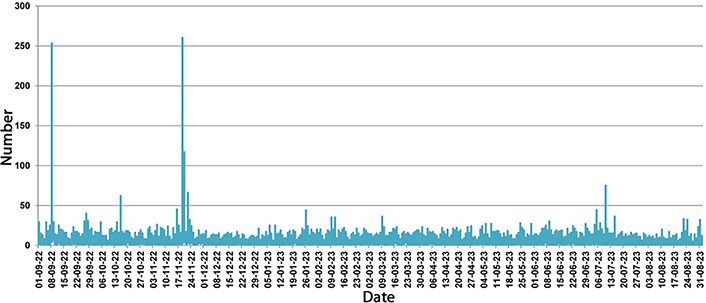
Trends of the volume of tweets containing #physiotherapy between 01 September 2022 to 01 September 2023
Among the 21,244 users that posted with the studied hashtag, the majority (8,922, 42%) had 100–1000 followers, or < 100 followers (6,713, 31.6%). A more detailed distribution of users according to followers is shown in Figure 2.
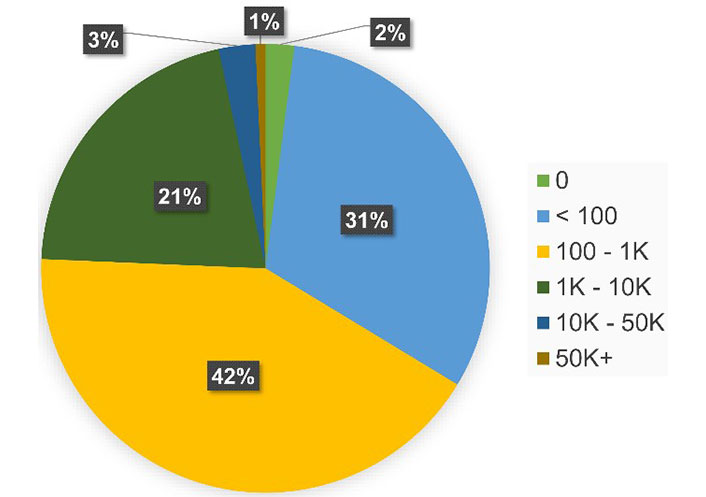
Distribution of X users that posted #physiotherapy tweets according to their number of followers
Examination of the accounts that posted the most #physiotherapy tweets reveals that the 9 most active accounts posted between 776 and 227 posts each and represented a balanced mix of professional bodies and specialized networks (4 of 9), and individual practitioners or doctors (5 of 9), showcasing the diverse voices shaping the online discourse on physiotherapy.
Analysis of the top 10 hashtags of the #physiotherapy-related tweets (Figure 3) reveals several widely used hashtags strongly related to physiotherapy. Thus, #physicaltherapy (5,275 mentions), #physio (4,523 mentions), and #physiotherapist (3,976 mentions) ranked in the first three places. The fourth place with 3,095 mentions was #fisioterapia (Spanish and Portuguese for physiotherapy). A review of the remaining six hashtags in the top ten list (Figure 3) indicates “pain” (#pain) as a major theme and also reflects the multifaceted nature of physiotherapy discussions, highlighting specifically back pain (#backpain), rehabilitation (#rehabilitation, #rehab), general health (#health), and massage (#massage), overall reflecting the major aims of physiotherapy to be used in rehabilitation, to enhance health, and to reduce discomfort and pain.
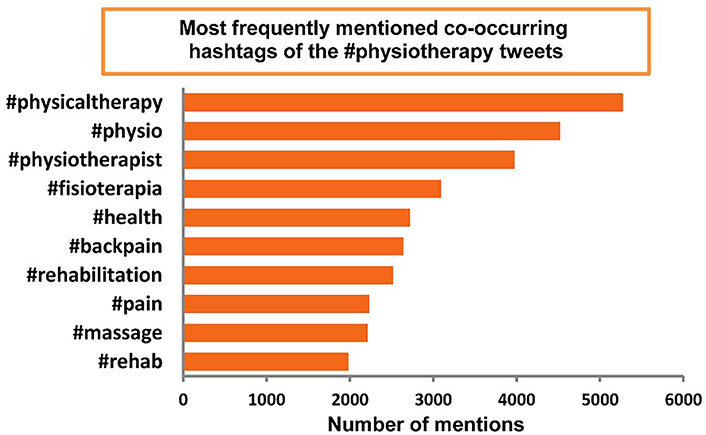
Top associated hashtags with #physiotherapy between 01 September 2022 to 01 September 2023
A total of 146 countries had Twitter with #physiotherapy and the top 10 countries are shown in Figure 4. The top three countries with tweets with #physiotherapy are the UK (29.9%), India (23.75%), and the USA (11.85%) totaling 65.5% of tweets among all the countries.
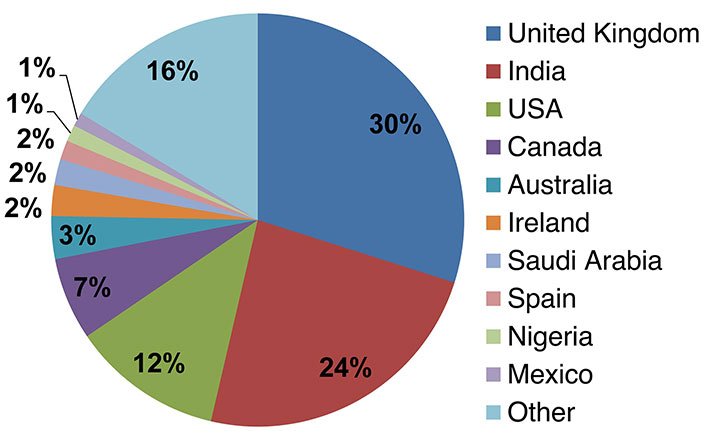
Top 10 countries with posts with #physiotherapy between 01 September 2022 to 01 September 2023
The sentiment of the posts showed that a total of 84% of the tweets were having neutral tone, with 9% positive tone, and 7% negative tone (P < 0.0001). The most posted URL in the analyzed dataset (with 206 mentions) belonged to a physiotherapy practice. On average, posts received 0.43 ± 6.6 reposts, 1.87 ± 25.05 likes, and 0.04 ± 0.39 quotes. Hence, it appears that users “like” the posts more than reposting, replying, and quoting (Figure 5).
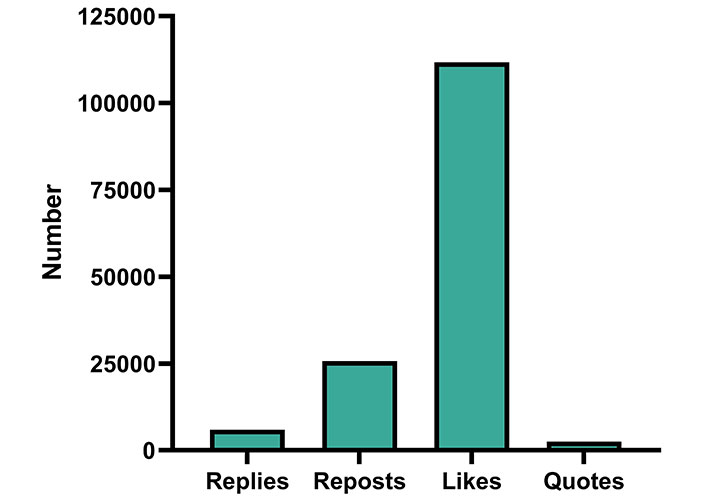
Number of total replies, reposts, likes, and quotes to the tweets containing the hashtag #physiotherapy
Discussion
The analysis of tweets and user engagement surrounding the hashtag #physiotherapy over a year revealed a considerable and enduring online presence. This suggests a strong and sustained interest in physiotherapy within the digital sphere, with a diverse group of users actively participating in discussions and information sharing. The significant reach of these tweets, as indicated by the high number of impressions, implies that the hashtag has potential as a valuable platform for disseminating knowledge and promoting awareness about physiotherapy-related topics [18, 19].
A sudden surge in X hashtag posts can be attributed to a multitude of factors. It often occurs when current events, viral content, social movements, or trending topics capture the collective attention of users. Celebrities and influencers, as well as well-executed marketing campaigns, can also trigger spikes in hashtag usage. In our study, one of the reasons for such a spike was the campaign for World Physiotherapy Day (celebrated on 8 September every year). Online communities, events, and seasonal occasions, like holidays or specific celebrations, encourage heightened hashtag activity. Contests, giveaways, and social media challenges that require hashtag inclusion can lead to temporary increases in posts [20–22]. These factors may be considered for targeted information education and communication activities.
The findings reveal that among the 21,244 users included in the analysis, the largest group falls within the range of 100 to 1,000 followers, representing 42% of the total users. This suggests a significant proportion of users with a moderately sized following. Additionally, a substantial number, 31.6% of the users, have fewer than 100 followers. This implies that a notable portion of the user base may have a smaller activity level and reach on the platform. These findings highlight the diversity in user influence and reach within the examined X community, with potential implications for information dissemination and engagement patterns based on user follower counts. X also has the feature of posting photographs and videos, and creating polls to collect health-related data [23]. However, well-executed visibility promotion is of great importance as all campaigns may not be successful in reaching a big audience [24].
The prevalence of the hashtag #physiotherapy in the UK, India, and the USA can be attributed to a confluence of factors. These countries often have well-established physiotherapy services and emphasize their role in healthcare, leading to increased online activity and discussions [25]. Moreover, the population size and the widespread adoption of the English language in these nations contribute to the hashtag’s global reach and appeal. The strong digital connectivity in these regions, with high internet penetration and social media usage, facilitates active participation in online conversations and the sharing of content related to physiotherapy. Cultural attitudes, demographics, and the significance of healthcare within these countries also shape the level of interest and engagement in physiotherapy-related topics. There could be more unexplored reasons which are yet to be studied [26, 27].
The frequent presence of associated hashtags like #fisioterapia and #health in posts using the hashtag #physiotherapy underscores the international reach and the integral importance for the health of various themes within the realm of physiotherapy. Such associated hashtags provide users with a means to further categorize and refine their content, catering to a diverse audience. #Fisioterapia, for instance, represents the Portuguese- and Spanish-speaking community’s engagement with physiotherapy, broadening the discussion to a global scale. Additionally, the ranking of #health in the top ten list (Figure 3) emphasizes the intersection of physiotherapy with broader healthcare discussions, encouraging a holistic approach to health and wellness. The importance of associated hashtags in social media posts is determined by their utility to help influencers or organizations better understand posting trends and ultimately reach more people for specific promotions. Such hashtags serve as valuable tools for content categorization and discovery. By incorporating relevant associated hashtags into posts, users can effectively classify their content, making it easier for others to find and engage with posts on specific topics, particularly upon using broader or popular hashtags [28]. This categorization simplifies the process of narrowing down content to one’s interests. Furthermore, associated hashtags play a significant role in expanding the reach of posts. When users utilize popular or trending associated hashtags, their content gains visibility to a larger and potentially more diverse audience. This not only increases the chances of engagement but also facilitates the exploration of different aspects of a given topic, contributing to a richer and more dynamic online conversation [29, 30].
The significance of the finding that sentiment analysis revealed 84% of the tweets carried a neutral tone, while 9% conveyed a positive tone, and 7% had a negative tone, lies in its implications for the perception and engagement surrounding the hashtag #physiotherapy. The predominance of neutral sentiment suggests that a substantial portion of the X discourse on physiotherapy may be focused on sharing information, news, or facts, indicating an objective and informative environment. The presence of positive sentiment, albeit in a smaller percentage, underscores the potential for hashtag-related discussions to serve as a platform for advocacy, encouragement, and the celebration of the field. An example of a study that reported a positive sentiment, is a work examining attitudes towards corona virus disease 2019 (COVID-19) vaccination [31]. However, the context of the latter work was different, with an ongoing pandemic and infodemic. The presence of negative sentiment, even at a lower percentage, highlights areas of concern or criticism within the community, emphasizing the need for constructive dialogue and potential areas of improvement. As an example of a topic with a strong negative sentiment, a study found that more than 50% of the tweets with heat illness discussion were charged with negative sentiment [32]. Overall, the conducted sentiment analysis in the present work provides valuable insights into the nature of discussions surrounding physiotherapy on X and can inform strategies to foster more positive engagement and address issues or concerns raised by users.
The finding that users liked tweets the most, followed by reposts, with replies and quotes being less popular, reflects the typical hierarchy of user engagement on X. The implication of this pattern is that users typically prefer to express their approval or agreement with a tweet by simply liking it, which is the most effortless form of engagement. Reposts indicate a higher level of engagement, as users are willing to share the content with their followers, extending its reach. Replies and quotes, on the other hand, require more effort and often involve expressing opinions or adding commentary to the original tweet. The lower frequency of replies and quotes suggests that users might be less inclined to engage in more detailed or interactive discussions on this particular topic. This finding highlights the importance of tailoring engagement strategies to the preferences and behaviors of the target audience when using X as a platform for content dissemination and interaction [16]. The balanced presence of individual and organizational accounts in the top ten most active accounts that posted #physiotherapy tweets, suggests a collaborative and interactive online community within the physiotherapy domain [33].
The novelty of this study lies in its comprehensive and longitudinal analysis of the use of the hashtag #physiotherapy on X over a one-year period. This extended timeframe allows for the observation of trends and changes in online discussions related to physiotherapy, providing a deeper understanding of the field’s sustained online presence and demonstration of the sustained interest of the online community in the topic. Additionally, the study’s exploration of geographic variation by identifying the top engaging countries, including the UK, India, and the USA, underscores the global impact of physiotherapy and adds a novel dimension to the research. The sentiment analysis component is another innovative aspect, offering insights into the emotional and attitudinal aspects of online conversations, which can inform strategies for fostering a more constructive and supportive online community focused on physiotherapy.
However, certain limitations should be acknowledged. The study’s reliance on a specific sample of X data may limit the generalizability of its findings, as the sample might not fully represent all relevant discussions on the topic [34]. Additionally, sentiment analysis may not be accurate for non-English-speaking posts due to cultural diversity. The subjectivity inherent in sentiment analysis, variations in interpretation, and the lack of consideration of contextual information represent further limitations that need to be considered when assessing the study’s results.
In conclusion, this study provided valuable insights into the dynamics of the hashtag #physiotherapy on X over a one-year period. The significant volume of tweets and impressions highlights the enduring interest and engagement in physiotherapy-related discussions within the digital sphere. The distribution of users based on follower counts indicates a diverse user engagement with varying degrees of influence, potentially influencing the reach of information shared under this hashtag. The prominence of the UK, India, and the USA in hashtag usage reflects the global impact of physiotherapy and underscores the role of digital connectivity and language in facilitating discussions. Sentiment analysis shed light on the overall tone of these discussions, with the majority of tweets being associated with neutral sentiment. Additionally, the hierarchy of user engagement, favoring likes and reposts over replies and quotes, provides insights into user behavior and preferences. Collectively, these findings contribute to a deeper understanding of the online presence and discourse surrounding physiotherapy on X, offering valuable considerations for future content dissemination strategies and community engagement in the field.
Abbreviations
| X: | social media X (formerly Twitter) |
Declarations
Acknowledgments
HM would like to thank Sarika Mondal and Ahana Aarshi for their technical help during the preparation of the manuscript and figures for this manuscript.
Author contributions
HM and AGA: Conceptualization, Investigation, Formal analysis, Writing—original draft, Writing—review & editing. MEM, MM, DH, MAS, FBM, JS, and EDP: Conceptualization, Data curation, Writing—review & editing. All authors read and approved the submitted version and take responsibility for its contents.
Conflicts of interest
Atanas G. Atanasov is the Editor-in-Chief of Exploration of Digital Health Technologies. Jivko Stoyanov and Emil D. Parvanov are Editorial Board members of Exploration of Digital Health Technologies. They had no involvement in the decision-making or the review process of this manuscript. The other authors declare that they have no conflicts of interest.
Ethical approval
Not applicable.
Consent to participate
Not applicable.
Consent to publication
Not applicable.
Availability of data and materials
Data is available from the corresponding authors upon request, with adequate justification.
Funding
Not applicable.
Copyright
© The Author(s) 2024.